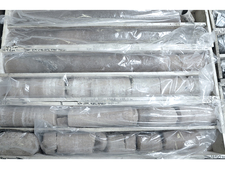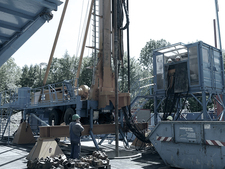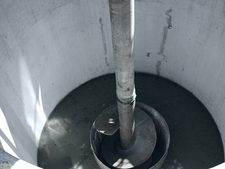Exploration drilling at the surface
End of exploration drilling from the surface: Drilling team reaches target mark
After having reached a drilling depth of 900 metres, the Asse-GmbH completed the exploration drilling from the surface for the planned recovery shaft 5. With the help of the drilling and additional subsequent measurements one wants to find out whether the area around the drilling site is suitable for a new shaft to be constructed there. The planned "shaft 5" is one of several important project components for the retrieval of the Asse waste.
In the weeks to come, geologists will sink radar probes into the bore hole. The data is to provide information about the nature of the salt rock between the mine and the drilling site. This way it is possible, for example, to determine whether the salt layer around the drilling site is massive enough or whether unwanted gas and water inclusions have to be expected. The Federal Office for Radiation Protection (BfS) plans to construct new infrastructure rooms for retrieval in the salt rock around the new shaft and connecting galleries to the existing mine workings containing the emplacement chambers.
The decision on whether the selected drilling site will be suitable for the planned shaft can only be taken after more evaluations and additional drillings underground have been carried out. It is planned to carry out the additional drillings from the existing mine workings on the level of the planned connection galleries. These drillings was startet in January 2015. Among others, what is key for the final evaluation is that no unwanted gas inclusions and/or rock layers are found via which water could enter the shaft from the cap rock later on.
March 2014: Exploration drilling reaches salt rock

![]() Proof of salt rock: Drill cores from a depth of up to 450 metres
Proof of salt rock: Drill cores from a depth of up to 450 metres
At the beginning of March 2014 the drilling team encountered salt in a depth of 444 metres. This is proven by drill cores which are drilled on a regular basis. Having reached the salt wash surface represents a new important drilling section.
Currently drilling has been interrupted because of a geophysical measurement programme. With the help of probes geologists can gain more information about the surrounding rock in a radius of several hundred metres. Parallel to this, scientists analyse the age of the drill cores in order to find out whether the Zechstein salt has been reached. The chambers and galleries of the Asse II mine are located in the Zechstein salt.
In the weeks to come the drillings will continue subject to specific safeguard measures, as it is possible that the salt contains gas. That is common practice in these cases. A so-called preventer, a protective valve above the bore hole, is to protect the workers against possible health-damaging gases such as hydrogen sulphide. It is planned to drill into a depth of 790 metres.
January 2014 – Exploration drilling in 260 metres started again
Currently the drilling works for the third drilling section are carried out, which was started in a depth of 260 metres. The engineers hope to encounter salt from a depth of about 420 metres. Then the works will probably proceed more easily than they have so far. However, the geological situation of the Asse mountain range is very challenging in terms of shaft sinking. The exact situation of the layers of the mountain can only be determined after the drill cores have been analysed and measurements in the bore hole have been carried out. Therefore one has to expect surprises in the course of the exploration.

![]() Drilling rig at the start of the exploration drilling
Drilling rig at the start of the exploration drilling
In the past, fault zones and jointing in the rock had caused difficulties during the drilling works carried out by the Asse GmbH and its subcontractors. At the beginning of July 2013, just one month after drilling works had started, the cementing lever system was torn while staff members of the Asse GmbH were stabilising the area around the bore hole with concrete. It was complicated to recover the lever system, so that drilling was interrupted for several weeks. In September 2013, the Asse GmbH resumed the exploration – so far without further problems.
Comprehensive stabilisation measures preceded the new section. The drilling team had consolidated the bore hole with a pipeline and extended it by some centimetres. Before that, geologists had carried out further measurements in the bore hole while drilling was interrupted. The data provides important findings concerning the nature and structure of rocks and rock masses.
June 2013: Start of drilling

![]() Drilling for new shaft 5 started – View into bore hole
Drilling for new shaft 5 started – View into bore hole
Drilling works started on 5 June 2013. Between single drilling phases, geophysical measurements are carried out in the open bore hole. The measurements provide important information, e.g. about the density of the rock, and serve to exactly determine the boundaries between the strata.
Furthermore, hydraulic tests are carried out during the drilling process and features such as the permeability and flow of the rocks are determined. Besides, rock-mechanical examinations are carried out at the drill cores and the mountain tension is determined in the drilling with the help of hydraulic tension measurements (in situ). The new shaft has to be designed to meet these forces coming from the rock.
The objective is to examine whether the assumptions on the geological situation at the drilling site are confirmed. The final depth of the drilling is planned to be 790 m, i.e. ca. 40 m below the level the emplacement chambers are located on.
Setting up the drilling area
The proposed drilling area being situated in a special landscape protection area (FFH), the exploration required authorisation by the rural district of Wolfenbüttel. The Asse GmbH also needed authorisation by the Landesamt für Bergbau, Energie und Geologie (LBEG). The authority accepted the operating plan for the drillings and for the establishment of the drilling area.
The first drilling works started in winter 2012. Prior to the breeding season, forest workers had cleared the area "Auf dem Klaare". Rare wild herbs were replanted properly. Additionally, comparatively complex works to seal the surface of the drilling area needed to be carried out to protect the surrounding FFH-area. In April 2013, the LBEG approved the operating plan for the exploration drilling.
The Asse GmbH had commissioned the following orders to be able to start exploring the shaft:
- Construction of the access road to the drilling area,
- Setting up the drilling area,
- Carrying out the exploration drilling.

